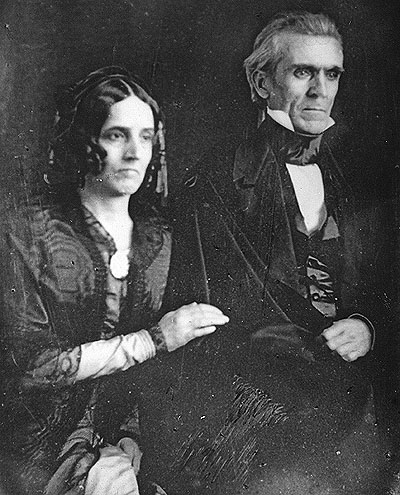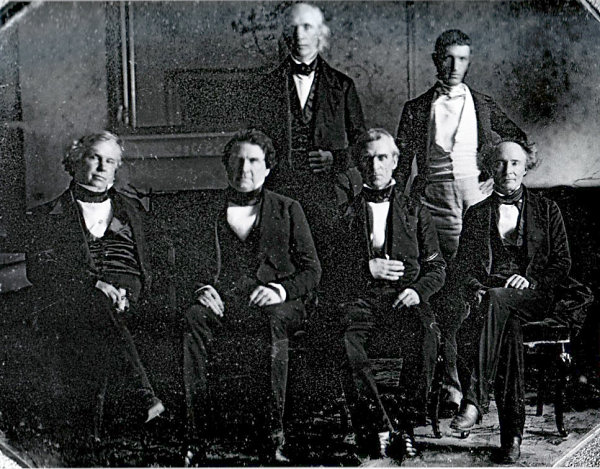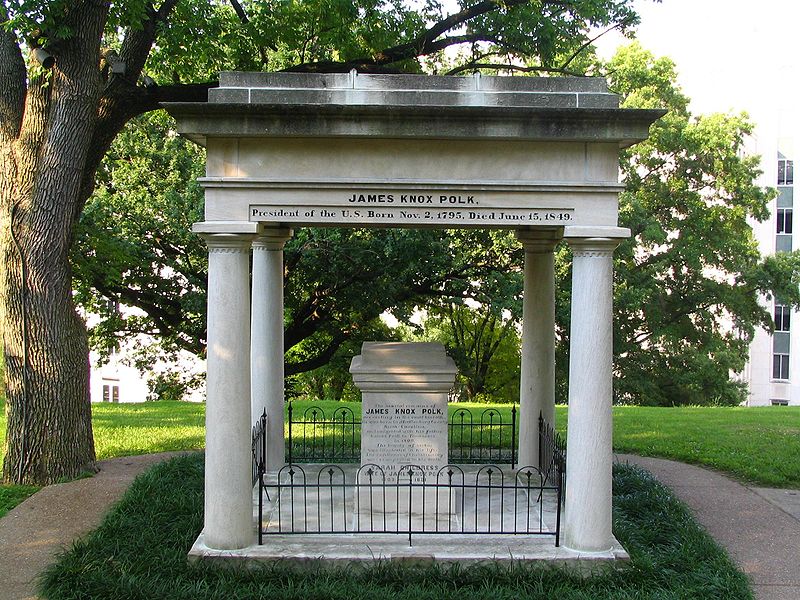<Back to Index>
- Mathematician Raphael Mitchel Robinson, 1911
- Poet Odysseas Elytis, 1911
- 11th President of the United States James Knox Polk, 1795
PAGE SPONSOR
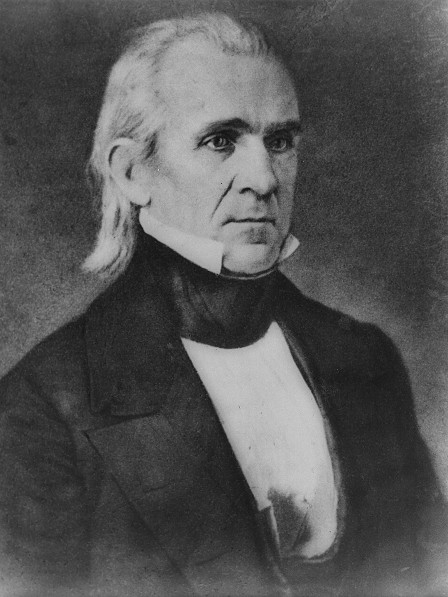
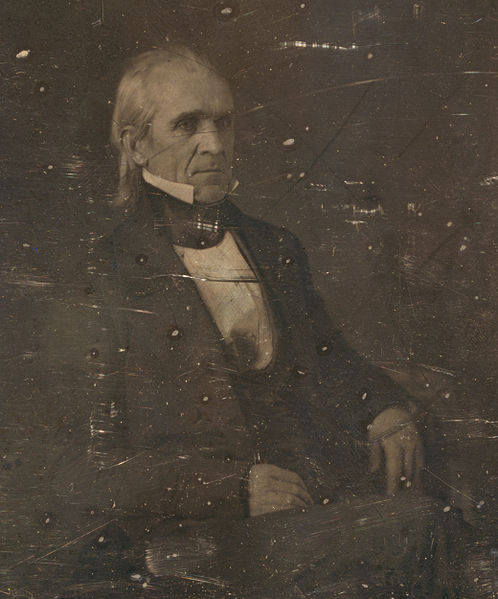
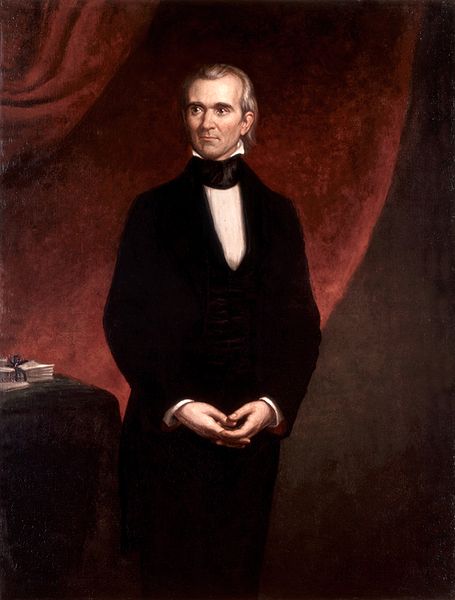
James Knox Polk (November 2, 1795 – June 15, 1849) was the 11th President of the United States (1845 – 1849). Polk was born in Mecklenburg County, North Carolina. He later lived in and represented the state of Tennessee. A Democrat, Polk served as Speaker of the House (1835 – 1839) and Governor of Tennessee (1839 – 1841). Polk was the surprise ("dark horse") candidate for president in 1844, defeating Henry Clay of the rival Whig Party by promising to annex Texas. Polk was a leader of Jacksonian Democracy during the Second Party System.
Polk was
the last strong pre-Civil War president. Polk is noted
for his foreign policy successes. He threatened war with Britain then backed away and split the
ownership of the Oregon region (the Pacific
Northwest) with Britain. When Mexico rejected American
annexation of Texas, Polk led the nation to a sweeping victory in the Mexican –
American War, followed by purchase of California, Arizona, and
New Mexico. He secured passage of the Walker tariff of 1846, which had low
rates that pleased his native South. He established a treasury system
that lasted until 1913. Polk oversaw the opening of the U.S. Naval
Academy and the Smithsonian
Institution, the groundbreaking for the Washington
Monument, and the issuance of the first postage stamps in
the United States. He promised to serve only one term and did not run
for reelection. He died of cholera three months after his term
ended. Scholars have ranked him
favorably on the list
of greatest presidents for
his ability to set an agenda and achieve all of it. Polk has been
called the "least known consequential president" of the United States. James
Knox Polk, the first of ten children, was born in a farmhouse (possibly
a "log" cabin) in what is
now Pineville,
North Carolina, in Mecklenburg
County on
November 2, 1795, just outside of Charlotte. His father, Samuel Polk, was a
slaveholder, successful farmer and surveyor of Scots - Irish descent. His mother, Jane
Polk (née Knox), was a descendant of a brother of the Scottish religious reformer John Knox.
She named her firstborn after her father James Knox. Like most early Scots - Irish
settlers in the North Carolina mountains, the Knox and Polk families
were Presbyterian.
While Jane remained a devout Presbyterian her entire life, Samuel
(whose father, Ezekial Polk, was a deist)
rejected dogmatic Presbyterianism. When the parents took James to
church to be baptized, the father Samuel refused to declare his belief
in Christianity, and the minister refused to baptize the child. In 1803, the majority of Polk's
relatives moved to the Duck River area in what is now Maury County,
Middle Tennessee; Polk's family waited until 1806 to follow. The family grew prosperous,
with Samuel Polk turning to land speculation and becoming a county
judge. Polk was home schooled. His health was problematic and in 1812
his pain became so unbearable that he was taken to Dr. Ephraim
McDowell of Danville,
Kentucky, who conducted an
operation to remove urinary
stones. The operation was conducted while Polk
was awake, with nothing but brandy then available for anesthetic, but it was successful. The surgery may
have left Polk sterile, as he did not sire any children. When
Polk recovered, his father offered to bring him into the mercantile
business, but Polk refused. In
July 1813, Polk enrolled at the Zion Church near his home. A year later
he attended an academy in Murfreesboro,
where he may have met his future wife, Sarah Childress. At Murfreesboro, Polk was
regarded as a promising student. In January 1816, he transferred and
was admitted into the University of
North Carolina as
a second semester sophomore. The Polks had connections with the
university, then a small school of about eighty students: Sam Polk was
their land agent for Tennessee, and his cousin, William Polk, was a
trustee. While there, Polk
joined the Dialectic
Society, in which he regularly took part in debates and learned
the art of oratory.
His roommate William Dunn
Moseley later
became the first governor of Florida. Polk graduated with honors in May
1818. After graduation, Polk traveled to Nashville to study law under renowned Nashville
trial attorney Felix
Grundy. Grundy became Polk's first mentor. On
September 20, 1819, Polk was elected to be the clerk for the Tennessee
State Senate with Grundy's endorsement. Polk was reelected as clerk in 1821
without opposition, and would continue to serve until 1822. Polk was
admitted to the bar in
June 1820 and his first case was to defend his father against a public
fighting charge, a case which he was able to get his father's release
for a fine of one dollar. Polk's practice was successful as there
were many cases regarding the settlement of debts following the Panic
of 1819. In
1821 Polk joined the local militia with the rank of Captain, and was
soon promoted to Colonel. Polk's
oratory became popular, earning him the nickname "Napoleon of the
Stump." In 1822 Polk resigned his position as clerk to run his
successful campaign for the Tennessee state legislature in 1823, in
which he defeated incumbent William Yancey,
becoming the new representative of Maury County. In October 1823 Polk voted for Andrew Jackson to become the next United
States Senator from Tennessee. Jackson won and from then on
Polk was a firm supporter of Jackson. Polk
courted Sarah Childress,
and they married on January 1, 1824. Polk
was then 28, and Sarah was 20 years old. Through their marriage they
had no children. They were married until his death in 1849. During
Polk's political career, Sarah was said to assist her husband with his
speeches, give him advice on policy matters and was always active in
his campaigns. An old story told that Andrew Jackson had encouraged
their romance when they began to court. In 1824, Jackson ran
for President but was defeated. Though Jackson had won the popular
vote, neither he nor any of
the other candidates (John
Quincy Adams, Henry
Clay, and William
H. Crawford)
had obtained a majority of the electoral vote. The House of
Representatives then had to select the verdict; Clay, who had received
the least amount of electoral votes and therefore was dropped from the
ballot, supported Adams. Clay's support proved to be the deciding
factor in the House and Adams was elected President. Adams then offered Clay a position in the
Cabinet as Secretary
of State. In
1825, Polk ran for the United States
House of Representatives for
the Tennessee's 6th
congressional district. Polk vigorously campaigned in
the district. Polk was so active that Sarah began to worry about his
health. During
the campaign, Polk's opponents said that at the age of 29 Polk was too
young for a spot in the House. However, Polk won the election and took
his seat in Congress. When Polk arrived in Washington D.C. he
roomed in a boarding house with some other Tennessee representatives,
including Benjamin Burch. Polk made his first major speech on March 13,
1826, in which he said that the Electoral
College should
be abolished and that the President should be elected by the popular
vote. After
Congress went into recess in the summer of 1826, Polk returned to
Tennessee to see Sarah, and when Congress met again in the autumn, Polk
returned to Washington with Sarah. In 1827 Polk was reelected to
Congress. In
1828, Jackson ran for President again and during the campaign Polk and
Jackson corresponded, with Polk giving Jackson advice on his campaign.
With Jackson's victory in the election Polk began to support the
administration's position in Congress. During
this time, Polk continued to be reelected in the House. In August 1833,
after being elected to his fifth term, Polk became the chair of the
House Ways and Means Committee. In
June 1834, Speaker of the House Andrew Stevenson resigned, leaving the spot
for speaker open. Polk ran against fellow
Tennessean
John Bell for
Speaker, and, after ten ballots, Bell won. However, in 1835, Polk ran
against Bell for Speaker again and won.
Polk
worked for Jackson's policies as speaker, and Van Buren's when he
succeeded Jackson in 1837; he appointed committees with Democratic
chairs and majorities, including the New York radical C.C. Cambreleng as Chair of the Ways and Means
Committee, although he maintained the facade of traditional
bipartisanship. The two major issues during
Polk's speakership were slavery and the economy, following the Panic of 1837.
Van Buren and Polk faced pressure to rescind the Specie Circular,
an act that had been passed by Jackson, in an attempt to help the
economy. The act required that payment for government lands be in gold
and silver. However, with support from Polk and his cabinet, Van Buren
chose to stick with the Specie Circular. Polk
attempted to make a more orderly house. He never challenged anyone to a
duel no matter how much they insulted his honor as was customary at the
time. Polk also issued the gag
rule on petitions from abolitionists. In
1838, the political situation in Tennessee — where, in 1835, Democrats
had lost the governorship for the first time in their party's history —
persuaded Polk to return to help the party at home. Leaving Congress in 1839, Polk
became a candidate in the Tennessee gubernatorial election, defeating
the incumbent Whig, Newton Cannon by about 2,500 votes, out
of about 105,000. Polk's
three major programs during his governorship; regulating state banks,
implementing state internal improvements, and improving education all
did not get approval by the legislature. In the presidential
election of 1840, Van Buren
was overwhelmingly defeated by a popular Whig, William
Henry Harrison. Polk received
one electoral vote from Tennessee for Vice
President in the election. Polk lost his own reelection bid to a
Whig, James
C. Jones, in 1841, by 3,243
votes. He
challenged Jones in 1843, campaigning across the state and publicly
debating against Jones, but was defeated again, this time by a slightly
greater margin of 3,833 votes. Polk
initially hoped to be nominated for vice-president at the Democratic
convention,
which began on May 27, 1844. The leading contender for the presidential
nomination was former President Martin Van Buren, who wanted to stop
the expansion of slavery. Other candidates included James Buchanan,
General
Lewis Cass, Cave Johnson, John C. Calhoun,
and Levi Woodbury.
The primary point of political contention involved the Republic of
Texas, which, after declaring independence from Mexico in
1836, had asked to join the United States. Van Buren opposed the
annexation but in doing so lost the support of many Democrats,
including former President Andrew Jackson, who still had much
influence. Van Buren won a simple majority on the convention's first
ballot but did not attain the two-thirds supermajority required for
nomination. After six more ballots, when it became clear that Van Buren
would not win the required majority, Polk was put forth as a "dark horse"
candidate. The eighth ballot was also indecisive, but on the ninth, the
convention unanimously nominated Polk, supported by Jackson. Before
the convention, Jackson told Polk that he was his favorite for the
nomination of the Democratic Party. Even with this support, Polk still
instructed his managers at the convention to support Van Buren, but
only if it was certain that Van Buren had a chance to win the
nomination. This assured that if a deadlocked convention occurred,
initial supporters of Van Buren would pick Polk as a compromise
candidate for the Democrats. In the end, this is exactly what happened
as a result for Polk's support of westward expansion. When
advised of his nomination, Polk replied: "It has been well observed
that the office of President of the United States should neither be
sought nor declined. I have never sought it, nor should I feel at
liberty to decline it, if conferred upon me by the voluntary suffrages of
my fellow citizens." Because the Democratic Party was splintered into
bitter factions, Polk promised to serve only one term if elected,
hoping that his disappointed rival Democrats would unite behind him
with the knowledge that another candidate would be chosen in four years. Polk's
Whig opponent in the 1844
presidential election was Henry Clay of Kentucky. (Incumbent
Whig President John Tyler
— a former Democrat — had become estranged from the Whigs and was not
nominated for a second term.) The question of the annexation of
Texas,
which was at the forefront during the Democratic Convention, again
dominated the campaign. Polk was a strong proponent of immediate
annexation, while Clay seemed more equivocal and vacillating. Another
campaign issue, also related to westward expansion, involved the Oregon Country,
then under the joint occupation of the United States and Great Britain.
The Democrats had championed the cause of expansion, informally linking
the controversial Texas annexation issue with a claim to the entire
Oregon Country, thus appealing to both Northern and Southern
expansionists. (The slogan "Fifty-Four Forty or Fight," often
incorrectly attributed to the 1844 election, did not appear until
later.)
Polk's consistent support for westward expansion — what Democrats would
later call "Manifest
Destiny" — likely played an important role in his victory, as
opponent Henry Clay hedged his position. In the
election, Polk and his running mate, George M. Dallas,
won in the South and West,
while Clay drew support in the Northeast.
Polk lost his home state of Tennessee, but he won the crucial state of
New York (with the support of many Van Buren supporters, since it was
his home state), where Clay lost supporters to the third-party candidate James G. Birney of
the Liberty Party, who was antislavery. Also contributing to Polk's
victory was the support of new immigrant voters, who were angered at
the Whigs' policies. Polk won the popular vote by a margin of about
39,000 out of 2.6 million, and took the Electoral College with 170
votes to Clay's 105. Polk won 15 states, while Clay
won 11. Polk is the only Speaker of the House of
Representatives to be elected President of the United States. When
he took office on March 4, 1845, Polk, at 49, became the youngest man
at the time to assume the presidency. According to a story told decades
later by George Bancroft,
Polk set four clearly defined goals for his administration: Pledged
to serve only one term, he accomplished all these objectives in just
four years. By linking acquisition of new lands in Oregon (with no
slavery) and Texas (with slavery), he hoped to satisfy both North and
South. During his presidency James
K. Polk was known as "Young Hickory", an allusion to his mentor Andrew
Jackson, and "Napoleon of the Stump" for his speaking skills. In
1846, Congress approved the Walker Tariff (named after Robert J. Walker,
the Secretary of
the Treasury), which represented a substantial reduction of the
high Whig backed Tariff of 1842.
The new law abandoned ad valorem tariffs;
instead, rates were made independent of the monetary value of the
product. Polk's actions were popular in the South and West; however,
they earned him the enmity of many protectionists in Pennsylvania. In
1846, Polk approved a law restoring the Independent Treasury System,
under which government funds were held in the Treasury rather than in
banks or other financial institutions. This established independent
treasury deposit offices, separate from private or state banks, to
receive all government funds. During
his presidency, many abolitionists harshly criticized him as an
instrument of the "Slave Power",
and claimed that the expansion of slavery lay behind his support for the annexation
of Texas and
later war with Mexico. Polk stated in his diary that
he believed slavery could not exist in the territories won from Mexico, but refused to endorse the Wilmot Proviso that would forbid it there.
Polk argued instead for extending the Missouri
Compromise line
to the Pacific Ocean, which would prohibit the expansion of slavery
above 36° 30' west of Missouri,
but allow it below that line if approved by eligible voters in the
territory. William
Dusinberre has
argued that Polk's diary, which he kept during his presidency, was
written for later publication, and does not represent Polk's real
policy. Polk
was a slaveholder for his entire life. His father, Alabaster Polk, had
left Polk more than 8,000 acres (32 km²) of land, and divided
about 53 slaves to his widow and children after Samuel died. James
inherited twenty of his father's slaves, either directly or from
deceased brothers. In 1831, he became an absentee cotton planter,
sending slaves to clear plantation land that his father had left him
near Somerville,
Tennessee.
Four years later Polk sold his Somerville plantation and, together with
his brother-in-law, bought 920 acres (3.7 km²) of land, a
cotton plantation near Coffeeville,
Mississippi.
He ran this plantation for the rest of his life, eventually taking it
over completely from his brother-in-law. Polk rarely sold slaves,
although once he became President and could better afford it, he bought
more. Polk's will stipulated that their slaves were to be freed after
his wife Sarah had died. However, the 1863
Emancipation Proclamation and the 1865 Thirteenth
Amendment to the United States Constitution freed all remaining slaves in rebel
states long before the death of his wife in 1891. Polk
was committed to expansion: Democrats believed that opening up more
land for yeoman farmers was critical for the success of republican
virtue.
Like most Southerners, he supported the annexation of Texas. To balance
the interests of North and South, he wanted to acquire the Oregon
Country (present day Oregon, Washington, Idaho,
and British Columbia)
as well. He sought to purchase California, which Mexico had neglected. Polk put
heavy pressure on Britain to resolve the Oregon boundary
dispute.
Since 1818, the territory had been under the joint occupation and
control of Great Britain and the United States. Previous U.S.
administrations had offered to divide the region along the 49th parallel,
which was not acceptable to Britain, as they had commercial interests
along the Columbia River.
Although the Democratic platform asserted a claim to the entire region,
Polk was prepared to quietly compromise. When the British again refused
to accept the 49th parallel boundary proposal, Polk broke off
negotiations and returned to the Democratic platform "All
Oregon" demand (which called for all of Oregon up to the 54 - 40 line
that marked the southern boundary of Russian Alaska). "54 - 40 or
fight!"
now became a popular rallying cry among Democrats. Polk wanted territory, not war, so he
compromised with the British Foreign Secretary, Lord
Aberdeen. The Oregon
Treaty of
1846 divided the Oregon Country along the 49th parallel, the original
American proposal. Although there were many who still clamored for the
whole of the territory, the treaty was approved by the Senate. By
settling for the 49th parallel, Polk angered many midwestern Democrats.
Many of these Democrats believed that Polk had always wanted the
boundary at the 49th, and that he had fooled them into believing he
wanted it at the 54th
parallel.
The portion of Oregon territory acquired by the United States later
formed the states of Washington, Oregon, and Idaho, and parts of the
states of Montana and Wyoming. President
Tyler despised Polk, both as a person and politician. Upon hearing of
Polk's election to office, Tyler urged Congress to pass ajoint resolution admitting Texas to the Union;
Congress complied on February 28, 1845. Texas promptly accepted the
offer and officially became a state on December 29, 1845. The
annexation angered Mexico,
which had lost Texas in
1836.
Mexican politicians had repeatedly warned that annexation would lead to
war. Nonetheless, Polk declared in his inaugural address, just days
after the resolution passed Congress, that the decision of annexation
belonged exclusively to Texas and the United States. After
the Texas annexation, Polk turned his attention to California, hoping
to acquire the territory from Mexico before any European nation did so.
The main interest was San Francisco
Bay as an access
point for trade with Asia. In 1845, he sent diplomat John Slidell to Mexico to purchase
California and New Mexico for
$24 – 30 million. Slidell's arrival caused political turmoil in Mexico
after word leaked out that he was there to purchase additional
territory and not to offer compensation for the loss of Texas. The
Mexicans refused to receive Slidell, citing a technical problem with
his credentials. In January 1846, to increase pressure on Mexico to
negotiate, Polk sent troops under General Zachary Taylor into
the area between the Nueces River and the Rio Grande —
territory that was claimed by both the U.S. and Mexico.
Slidell
returned to Washington in May 1846, having been rebuffed by the Mexican
government. Polk regarded this treatment of his diplomat as an insult
and an "ample cause of war", and he prepared to ask Congress
for a declaration of war. Meanwhile Taylor crossed the Rio Grande River
and briefly occupied Matamoros,
Tamaulipas.
Taylor continued to blockade ships from entering the port of Matamoros.
Mere days before Polk intended to make his request to Congress, he
received word that Mexican forces had crossed the Rio Grande area and
killed eleven American soldiers. Polk then made this the casus belli,
and in a message to Congress on May 11, 1846, he stated that Mexico had
"invaded our territory and shed American blood upon the American soil."
Some Whigs in Congress, such as Abraham Lincoln,
challenged Polk's version of events,
but Congress overwhelmingly approved the declaration of war. Many Whigs
feared that opposition would cost them politically by casting
themselves as unpatriotic for not supporting the war effort. In the House, antislavery Whigs led by John
Quincy Adams voted against the war; among Democrats,
Senator John
C. Calhoun was the most notable opponent of the
declaration. Polk
selected the top generals and set the overall military strategy of the
war. By the summer of 1846, American forces under General Stephen W.
Kearny had captured New Mexico. Meanwhile, Army captain John C.
Frémont led
settlers in northern California to overthrow the Mexican garrison in
Sonoma (in the Bear Flag Revolt).
General Zachary Taylor, at the same time, was having success on the Rio
Grande, although Polk did not reinforce his troops there. The United
States also negotiated a secret arrangement with Antonio
López de Santa Anna,
the Mexican general and dictator who had been overthrown in 1844. Santa
Anna agreed that, if given safe passage into Mexico, he would attempt
to persuade those in power to sell California and New Mexico to the
United States. Once he reached Mexico, however, he reneged on his
agreement, declared himself President, and tried to drive the American
invaders back. Santa Anna's efforts, however, were in vain, as Generals
Taylor and Winfield Scott destroyed
all resistance. Scott captured Mexico City in September 1847, and
Taylor won a series of victories in northern Mexico. Even after these
battles, Mexico did not surrender until 1848, when it agreed to peace
terms set out by Polk. Polk
sent diplomat Nicholas Trist to
negotiate with the Mexicans. Lack of progress prompted the President to
order Trist to return to the United States, but the diplomat ignored
the instructions and stayed in Mexico to continue bargaining. Trist
successfully negotiated theTreaty of
Guadalupe Hidalgo in
1848, which Polk agreed to ratify, ignoring calls from Democrats who
demanded the annexation of the whole of Mexico. The treaty added 1.2
million square miles (3.1 million square kilometers) of territory to
the United States; Mexico's size was halved, while that of the United
States increased by a third. California, Nevada, Utah,
most of Arizona,
and parts of New Mexico, Colorado and Wyoming were
all included in the Mexican Cession. The treaty also recognized the
annexation of Texas and acknowledged American control over the disputed
territory between the Nueces River and
the Rio Grande. Mexico, in turn, received the sum of $15 million. The
war claimed fewer than 20,000 American lives but over 50,000 Mexican
ones. It may have cost the United
States $100 million. Finally, the Wilmot Proviso injected
the issue of slavery in the new territories, even though Polk had
insisted to Congress and in his diary that this had never been a war
goal. The
treaty, however, needed ratification by the Senate. In March 1848, the
Whigs, who had been so opposed to Polk's policy, suddenly changed
position. Two-thirds of the Whigs voted for Polk's treaty. This ended
the war and legalized the acquisition of the territories. The
war had serious consequences for Polk and the Democrats. It gave the
Whig Party a unifying message of denouncing the war as an immoral act
of aggression carried out through abuse of power by the president. In
the 1848 election, however, the Whigs nominated General Zachary
Taylor,
a war hero, and celebrated his victories. Taylor refused to criticize
Polk. As a result of the strain of managing the war effort directly and
in close detail, Polk's health markedly declined toward the end of his
presidency. One
of Polk's last acts as President was to sign the bill creating the Department of
the Interior (March
3, 1849). This was the first new cabinet position created since the
early days of the Republic. Polk's
time in the White House took
its toll on his health. Full of enthusiasm and vigor when he entered
office, Polk left on March 4, 1849, exhausted by his years of public
service. He lost weight and had deep lines on his face and dark circles
under his eyes. He is believed to have contracted cholera in New Orleans, Louisiana,
on a goodwill tour of the South. He
died at his new home, Polk Place, in Nashville,
Tennessee,
at 3:15 p.m. on June 15, 1849, three months after leaving office. He
was buried on the grounds of Polk Place. Polk's devotion to his wife is
illustrated by his last words: "I love you, Sarah. For all eternity, I
love you." She lived at Polk Place for
over forty years after his death. She died on
August 14, 1891. Polk was also survived by his mother, Jane Knox Polk. Polk had the
shortest retirement of
all Presidents at 103 days. He was the youngest former president to die
in retirement at the age of 53. He and his wife are buried in a tomb on
the grounds of the Tennessee
State Capitol in Nashville, Tennessee. The tomb was
moved to this location in 1893 after his home at Polk
Place was demolished. Polk's
historic reputation was largely formed by the attacks made on him in
his own time; the Whigs claimed that he was drawn from a well deserved
obscurity; Senator Tom Corwin of Ohio remarked "James K.
Polk, of Tennessee? After
that,
who is safe?" The Republican historians of the nineteenth century
inherited this view. Polk was a compromise between the Democrats of the
North, like David Wilmot and Silas Wright,
and the plantation owners who were led by John C. Calhoun;
the northern Democrats thought that when they did not get their way, it
was because he was the tool of the slaveholders, and the conservatives
of the South insisted that he was the tool of the northern Democrats.
These views were long reflected in the historical literature, until Arthur M.
Schlesinger, Jr and Bernard De Voto argued that Polk was
nobody's tool, but set his own goals and achieved them.
Polk
is now recognized, not only as the strongest president between Jackson
and Lincoln, but the president who made the United States a
coast-to-coast nation. When historians began ranking the presidents in
1948, Polk ranked 10th in Arthur M.
Schlesinger’s poll and has subsequently ranked 8th in
Schlesinger’s 1962 poll, 11th
in the Riders - McIver Poll (1996), 11th in the most recent Siena Poll
(2002), 9th in the most recent Wall
Street Journal Poll
(2005), and 12th in the latest C-Span Poll (2009). Polk
biographers over the years have sized up the magnitude of Polk’s
achievements and his legacy, particularly his two most recent. “There
are three key reasons why James K. Polk deserves recognition as a
significant and influential American president,” Walter Borneman wrote.
“First, Polk accomplished the objectives of his presidential term as he
defined them; second, he was the most decisive chief executive prior to
the Civil War;
and third, he greatly expanded the executive power of the presidency,
particularly its war powers, its role as commander in chief, and its
oversight of the executive branch." President Harry S. Truman summarized this view by saying
that Polk was "a great president. Said what he intended to do and did
it." While
Polk’s legacy thus takes many forms, the most outstanding is the map of
the continental United States, whose landmass he increased by a third.
“To look at that map,” Robert Merry concluded, “and to take in the
western and southwestern expanse included in it, is to see the
magnitude of Polk’s presidential accomplishments.” Nevertheless,
the Polk's aggressive expansionism has been criticized on ethical
grounds. In a sentence, he believed in "Manifest Destiny" to a much
greater extent than most. In reference to the Mexican - American War,
General Ulysses
S. Grant stated
that "I was bitterly opposed to the [Texas annexation], and to this day
regard the war, which resulted, as one of the most unjust ever waged by
a stronger against a weaker nation. It was an instance of a republic
following the bad example of European monarchies, in not considering
justice in their desire to acquire additional territory." Whig politicians, including David
Wilmot, Abraham
Lincoln and John
Quincy Adams contended that
the Texas
Annexation and the Mexican
Cession enhanced the pro-slavery
factions of the United States. Unsatisfactory
conditions pertaining to the status of slavery in the territories
acquired during the Polk administration lead to the Compromise
of 1850, one of the primary
factors in the establishment of the Republican
Party and later the beginning of the American
Civil War.
In
the summer of 1848, President Polk authorized his ambassador to Spain, Romulus
Mitchell Saunders, to negotiate the purchase of Cuba and
offer Spain up to $100 million, an astounding sum of money at the time
for one territory, equivalent to $2.51 billion in present day
terms. Cuba
was close to the United States and had slavery, so the idea appealed to
Southerners but was unwelcome in the North. But Spain was still making
huge profits in Cuba (notably in sugar, molasses, rum, and tobacco),
and the Spanish government rejected Saunders' overtures.
